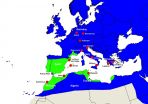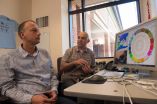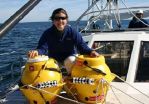The researchers think these instances of introgressive hybridization -- a way for genetic material and, potentially, traits to be passed from one species to another through interspecific mating -- are only the first of many needles waiting to be found in a very large genetic haystack. While introgressive hybridization is thought to be common among plants, the finding suggests that hybridization in mammals may not be the evolutionary dead end biologists once commonly thought.
Rice biologist Michael Kohn and computer scientist Luay Nakhleh reported that two species of mice from various locations in Europe and Africa have shared genetic code to their apparent evolutionary advantage at least three times over the centuries.
Kohn, who tracks the genetic roots of mice to see how favorable evolutionary traits develop, and Nakhleh, who studies evolution by comparing genomic data, shared their findings this week in the Proceedings of the National Academy of Sciences.
Mice are common subjects for evolutionary studies of mammals because they breed quickly and a biologist can follow many generations in the span of one's career. The ability to track such interactions has implications for human genetics and health, the researchers said.
Kohn previously detailed a mutation in common European house mice (Mus musculus domesticus) that gave them resistance to warfarin, a rodent poison also used as a blood thinner in humans. Evidence indicated the mutation appeared in mice about 10 years after the introduction of warfarin and seemed connected to geographically distant Algerian mice (Mus spretus) that carried the same mutation.
But that project looked at only small sections of the mouse genome on one chromosome where the mutant gene in question, Vkorc1, was known to exist. "That gene had adaptively introgressed between these mice and was known to cause resistance at a time when some scientists thought such events should not happen," said Kohn, an associate professor of ecology and evolutionary biology.
"The question then became, Is it rare or is it common? With the approach we used in this paper, we now know it's not unique," he said. The new study compares genome-scale data of 21 mice that originated in 15 different locations in Europe and Africa.
Kohn, Nakhleh and lead author Kevin Liu, their former postdoctoral researcher and now an assistant professor at Michigan State University, employed Rice's supercomputers and the Nakhleh lab's open-source PhyloNet-HMM software to locate statistically likely connections between the re-sequenced complete genomes, some newly determined and some collected previously in a massive effort to understand the evolutionary origins of the laboratory mouse genome.
They turned up two more sets of genomic regions, or tracts, that showed hybridization events; one appears to predate the colonization of Europe by M. m. domesticus, and the other affected the subjects' sense of smell -- a definite evolutionary advantage for mice looking for food or mates. "That's apparently an important locus," Kohn said.
"The category that jumped out was the olfactory genes," said Nakhleh, an associate professor of computer science and of biosciences, who had been thinking about large-scale studies of the mouse genome with Kohn since both arrived at Rice in 2004. "Now one has to work through the biology to figure out how this hybridization happened."
"The new statistical method developed in Luay's group can only tell you whether an event is there or not. It cannot tell you why it's there or what it does. But it gives you a way to start looking," Kohn added.
He said the lengths of the shared genomic tracts provide the key to estimating their ages and evolutionary dynamics. The longer the region, the more recently the hybridization event occurred. And some may be "driver genes" that drag along adjacent chunks of DNA. "One challenge is to see which are driver genes, meaning they encode a biological function that could be favored by natural selection, and which are just tagging along," he said.
Kohn expects future studies will show evidence of more hybridization among mice from the regions studied and farther afield, though he also realizes many events will never be found.
"Hybrids don't always pass the test imposed by evolution and disappear from the record," he said. "We cannot measure them, because we can't count what we can't see."
Nakhleh said other studies may have missed evidence of hybridization because the researchers weren't specifically looking for it. "Why is it that biologists in general who look at mammalian genomes haven't found hybridization? I think it's because they started with the hypothesis that it couldn't be there and used tools that would ignore it.
"This paper shows the value of collaboration between biologists and 'big-data' scientists," he said. "It also shows there is a need to develop more sophisticated computational methods for biologists."
INFORMATION:
Co-authors of the paper are Rice undergraduate students Ethan Steinberg and Alexander Yozzo and former Rice postdoctoral researcher Ying Song, now at the Chinese Academy of Agricultural Sciences in Beijing.
The National Institutes of Health's National Heart, Lung and Blood Institute and National Library of Medicine, the National Science Foundation (NSF) and the Keck Center of the Gulf Coast Consortia supported the research. The researchers utilized the NSF-funded DAVinCi supercomputer administered by Rice's Ken Kennedy Institute for Information Technology.
Read the abstract at http://www.pnas.org/content/early/2014/12/10/1406298111.abstract
This news release can be found online at http://news.rice.edu/2014/12/16/big-data-analysis-reveals-gene-sharing-in-mice/
Follow Rice News and Media Relations via Twitter @RiceUNews
Related Materials:
Michael Kohn Lab: http://www.ruf.rice.edu/~hmkohn/index.html
Computer Science Bioinformatics Group (Nakhleh): http://bioinfo.cs.rice.edu
Kevin Liu: http://www.cse.msu.edu/~kjl/
Evolution software looks beyond the branches: http://news.rice.edu/2014/11/12/evolution-software-looks-beyond-the-branches-2/
Images for download:
http://news.rice.edu/wp-content/uploads/2014/12/1222_MOUSE-2-WEB.jpg
The species used in a Rice University genetic study of mice were collected from 15 locations in Europe and Africa. The green region indicates the range of Mus spretus, the Algerian mouse, while the blue region indicates the range of Mus musculus domesticus, the common European house mouse, which also occupies the green region and beyond. Algerian mouse samples were obtained in Puerto Real (purple diamond). The study showed at least three instances of introgressive hybridization between the two species. (Courtesy of the Kohn and Nakhleh Labs/Rice University)
http://news.rice.edu/wp-content/uploads/2014/12/1222_MOUSE-1-WEB.jpg
Rice University biologist Michael Kohn, left, and computer scientist Luay Nakhleh, right, discuss the results of a study of the genomes of European and African mice that showed signs of three distinct hybridization events between two mouse species. The researchers determined that such events are not unusual, though only those with traits favored by evolution survive. (Credit: Jeff Fitlow/Rice University)






